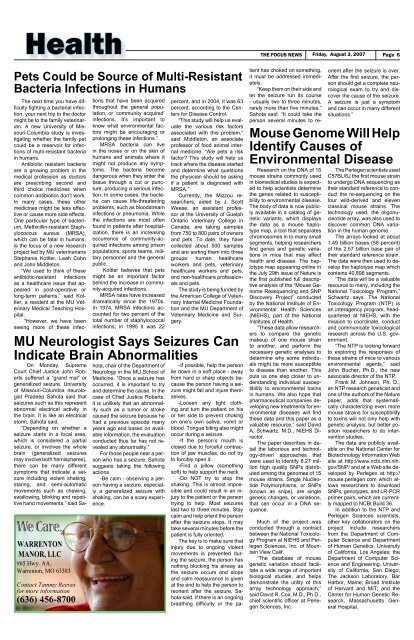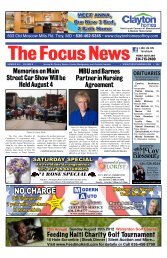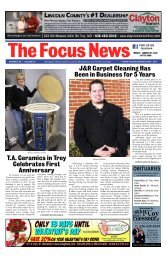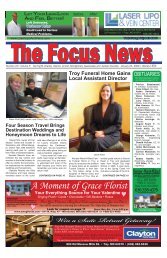August 3, 2007 - The Focus News
August 3, 2007 - The Focus News
August 3, 2007 - The Focus News
Create successful ePaper yourself
Turn your PDF publications into a flip-book with our unique Google optimized e-Paper software.
Health<br />
Pets Could be Source of Multi-Resistant<br />
Bacteria Infections in Humans<br />
<strong>The</strong> next time you have difficulty<br />
fighting a bacterial infection,<br />
your next trip to the doctor<br />
might be to the family veterinarian.<br />
A new University of Missouri-Columbia<br />
study is investigating<br />
whether the family pet<br />
could be a reservoir for infections<br />
of multi-resistant bacteria<br />
in humans.<br />
Antibiotic resistant bacteria<br />
are a growing problem in the<br />
medical profession as doctors<br />
are prescribing second and<br />
third choice medicines when<br />
common antibiotics don’t work.<br />
In many cases, these other<br />
medicines might be less effective<br />
or cause more side effects.<br />
One particular type of bacterium,<br />
Methicillin-resistant Staphylococcus<br />
aureus (MRSA),<br />
which can be fatal in humans,<br />
is the focus of a new research<br />
project led by MU veterinarians<br />
Stephanie Kottler, Leah Cohn<br />
and John Middleton.<br />
“We used to think of these<br />
antibiotic-resistant infections<br />
as a healthcare issue that appeared<br />
in post-operative or<br />
long-term patients,” said Kottler,<br />
a resident at the MU Veterinary<br />
Medical Teaching Hospital.<br />
“However, we have been<br />
seeing more of these infec-<br />
On Monday, Supreme<br />
Court Chief Justice John Roberts<br />
suffered a “grand mal” or<br />
generalized seizure. University<br />
of Missouri-Columbia neurologist<br />
Pradeep Sahota said that<br />
seizures such as this represent<br />
abnormal electrical activity in<br />
the brain. It is like an electrical<br />
storm, Sahota said.<br />
“Depending on whether a<br />
seizure starts in a focal area,<br />
which is considered a partial<br />
seizure, or involves the whole<br />
brain (generalized seizures<br />
may involve both hemispheres),<br />
there can be many different<br />
symptoms that indicate a seizure<br />
including violent shaking,<br />
staring, and semi-automatic<br />
movements such as chewing,<br />
swallowing, blinking and repetitive<br />
hand movements,” said Sa-<br />
We Care.<br />
WARRENTON<br />
MANOR, LLC<br />
#65 Hwy. AA,<br />
Warrenton, MO 63383<br />
Contact Tammy Reeves<br />
for more information<br />
(636) 456-8700<br />
tions that have been acquired<br />
throughout the general population,<br />
or ‘community acquired’<br />
infections. It’s important to<br />
know what environmental factors<br />
might be encouraging or<br />
prolonging these infections.”<br />
MRSA bacteria can live<br />
in the noses or on the skin of<br />
humans and animals where it<br />
might not produce any symptoms.<br />
<strong>The</strong> bacteria become<br />
dangerous when they enter the<br />
tissue through a cut or puncture,<br />
producing a serious infection.<br />
In some cases, the bacteria<br />
can cause life-threatening<br />
problems, such as bloodstream<br />
infections or pneumonia. While<br />
the infections are most often<br />
found in patients after hospitalization,<br />
there is an increasing<br />
occurrence of community-acquired<br />
infections among prison<br />
populations, sports teams, military<br />
personnel and the general<br />
public.<br />
Kottler believes that pets<br />
might be an important factor<br />
behind the increase in community-acquired<br />
infections.<br />
MRSA rates have increased<br />
dramatically since the 1970s.<br />
In 1974, MRSA infections accounted<br />
for two percent of the<br />
total number of staphylococcal<br />
infections; in 1995 it was 22<br />
percent, and in 2004, it was 63<br />
percent, according to the Centers<br />
for Disease Control.<br />
“This study will help us evaluate<br />
the various risk factors<br />
associated with this problem,”<br />
said Middleton, an associate<br />
professor of food animal internal<br />
medicine. “Are pets a risk<br />
factor? This study will help us<br />
track where the disease started<br />
and determine what questions<br />
the physician should be asking<br />
if a patient is diagnosed with<br />
MRSA.”<br />
Currently, the Mizzou researchers,<br />
aided by J. Scott<br />
Weese, an assistant professor<br />
at the University of Guelph<br />
Ontario Veterinary College in<br />
Canada, are taking samples<br />
from 750 to 800 pairs of owners<br />
and pets. To date, they have<br />
collected about 500 samples<br />
and are sorting them into three<br />
groups: human healthcare<br />
workers and pets, veterinary<br />
healthcare workers and pets,<br />
and non-healthcare professionals<br />
and pets.<br />
<strong>The</strong> study is being funded by<br />
the American College of Veterinary<br />
Internal Medicine Foundation<br />
and the MU Department of<br />
Veterinary Medicine and Surgery.<br />
MU Neurologist Says Seizures Can<br />
Indicate Brain Abnormalities<br />
hota, chair of the Department of<br />
Neurology in the MU School of<br />
Medicine. “Once a seizure has<br />
occurred, it is important to try<br />
and determine the cause. In the<br />
case of Chief Justice Roberts,<br />
it is unlikely that an abnormality<br />
such as a tumor or stroke<br />
caused the seizure because he<br />
had a previous episode many<br />
years ago and based on available<br />
information, the evaluation<br />
conducted thus far has not revealed<br />
any abnormality.”<br />
For those people near a person<br />
who has a seizure, Sahota<br />
suggests taking the following<br />
actions<br />
-Be calm - observing a person<br />
having a seizure, especially<br />
a generalized seizure with<br />
shaking, can be a scary experience.<br />
-If possible, help the person<br />
lie down in a soft place - away<br />
from hard or sharp objects because<br />
the person having a seizure<br />
might fall and injure themselves.<br />
-Loosen any tight clothing<br />
and turn the patient on his<br />
or her side to prevent choking<br />
on one’s own saliva, vomit or<br />
blood. Tongue biting also might<br />
occur during a seizure.<br />
-If the person’s mouth is<br />
closed due to forceful contraction<br />
of jaw muscles, do not try<br />
to forcibly open it.<br />
-Find a pillow (something<br />
soft) to help support the neck.<br />
-Do NOT try to stop the<br />
shaking. This is almost impossible<br />
and could result in an injury<br />
to the patient or the person<br />
trying to help. Most seizures<br />
last two to three minutes. Stay<br />
calm and help orient the person<br />
after the seizure stops. It may<br />
take several minutes before the<br />
patient is fully oriented.<br />
<strong>The</strong> key is to make sure that<br />
injury due to ongoing violent<br />
movements is prevented during<br />
the seizure, the person has<br />
nothing blocking his airway as<br />
the seizure occurs and stops<br />
and calm reassurance is given<br />
at the end to help the person to<br />
reorient after the seizure, Sahota<br />
said. If there is an ongoing<br />
breathing difficulty or the pa-<br />
THE FOCUS NEWS Friday, <strong>August</strong> 3, <strong>2007</strong> Page<br />
tient has choked on something,<br />
it must be addressed immediately.<br />
“Keep them on their side and<br />
let the seizure run its course<br />
- usually two to three minutes,<br />
rarely more than five minutes,”<br />
Sahota said. “It could take the<br />
person several minutes to re-<br />
Research on the DNA of 15<br />
mouse strains commonly used<br />
in biomedical studies is expected<br />
to help scientists determine<br />
the genes related to susceptibility<br />
to environmental disease.<br />
<strong>The</strong> body of data is now publicly<br />
available in a catalog of genetic<br />
variants, which displays<br />
the data as a mouse haplotype<br />
map, a tool that separates<br />
chromosomes in to many small<br />
segments, helping researchers<br />
find genes and genetic variations<br />
in mice that may affect<br />
health and disease. <strong>The</strong> haplotype<br />
map appearing online in<br />
the July 29th issue of Nature is<br />
the first published full descriptive<br />
analysis of the “Mouse Genome<br />
Resequencing and SNP<br />
Discovery Project” conducted<br />
by the National Institute of Environmental<br />
Health Sciences<br />
(NIEHS), part of the National<br />
Institutes of Health.<br />
“<strong>The</strong>se data allow researchers<br />
to compare the genetic<br />
makeup of one mouse strain<br />
to another, and perform the<br />
necessary genetic analyses to<br />
determine why some individuals<br />
might be more susceptible<br />
to disease than another. This<br />
puts us one step closer to understanding<br />
individual susceptibility<br />
to environmental toxins<br />
in humans. We also hope that<br />
pharmaceutical companies developing<br />
new treatments for environmental<br />
diseases will find<br />
these data and this paper as a<br />
valuable resource,” said David<br />
A. Schwartz. M.D., NIEHS Director.<br />
<strong>The</strong> paper describes in detail<br />
the laborious and technology-driven<br />
approaches that<br />
were used to identify 8.27 million<br />
high quality SNPs distributed<br />
among the genomes of 15<br />
mouse strains. Single Nucleotide<br />
Polymorphisms, or SNPs<br />
(known as snips), are single<br />
genetic changes, or variations,<br />
that can occur in a DNA sequence.<br />
Much of the project was<br />
conducted through a contract<br />
between the National Toxicology<br />
Program at NIEHS and Perlegen<br />
Sciences, Inc. of Mountain<br />
View Calif.<br />
“<strong>The</strong> database of mouse<br />
genetic variation should facilitate<br />
a wide range of important<br />
biological studies, and helps<br />
demonstrate the utility of this<br />
array technology approach,”<br />
said David R. Cox, M.D., Ph.D.,<br />
chief scientific officer at Perlegen<br />
Sciences, Inc.<br />
orient after the seizure is over.<br />
After the first seizure, the person<br />
should get a complete neurological<br />
exam to try and discover<br />
the cause of the seizure.<br />
A seizure is just a symptom<br />
and can occur in many different<br />
situations.”<br />
Mouse Genome Will Help<br />
Identify Causes of<br />
Environmental Disease<br />
<strong>The</strong> Perlegen scientists used<br />
C57BL/6J the first mouse strain<br />
to undergo DNA sequencing as<br />
their standard reference to conduct<br />
the re-sequencing on the<br />
four wild-derived and eleven<br />
classical mouse strains. <strong>The</strong><br />
technology used, the oligonucleotide<br />
array, was also used to<br />
discover common DNA variation<br />
in the human genome.<br />
<strong>The</strong> arrays looked at about<br />
1.49 billion bases (58 percent)<br />
of the 2.57 billion base pair of<br />
their standard reference strain.<br />
<strong>The</strong> data were then used to develop<br />
the haplotype map which<br />
contains 40,898 segments.<br />
“<strong>The</strong> data will be a valuable<br />
resource to many, including the<br />
National Toxicology Program,”<br />
Schwartz says. <strong>The</strong> National<br />
Toxicology Program (NTP) is<br />
an interagency program, headquartered<br />
at NIEHS, with the<br />
mission to coordinate, conduct<br />
and communicate toxicological<br />
research across the U.S. government.<br />
“<strong>The</strong> NTP is looking forward<br />
to exploring the responses of<br />
these strains of mice to various<br />
environmental agents,” said<br />
John Bucher, Ph.D., the new<br />
associate director of the NTP.<br />
Frank M. Johnson, Ph. D.,<br />
an NTP research geneticist and<br />
one of the authors of the Nature<br />
paper, adds that systematically<br />
characterizing even more<br />
mouse strains for susceptibility<br />
to toxins will not only help with<br />
genetic analysis, but better position<br />
researchers to do intervention<br />
studies.<br />
<strong>The</strong> data are publicly available<br />
on the National Center for<br />
Biotechnology Information Web<br />
site at http://www.ncbi.nlm.nih.<br />
gov/SNP/ and at a Web site developed<br />
by Perlegen at http://<br />
mouse.perlegen.com which allows<br />
researchers to download<br />
SNPs, genotypes, and LR-PCR<br />
primer pairs, which are currently<br />
mapped to NCBI Build 36.<br />
In addition to the NTP and<br />
Perlegen Sciences scientists,<br />
other key collaborators on the<br />
project include researchers<br />
from the Department of Computer<br />
Science and Department<br />
of Human Genetics, University<br />
of California, Los Angeles; the<br />
Department of Computer Science<br />
and Engineering, University<br />
of California, San Diego;<br />
<strong>The</strong> Jackson Laboratory, Bar<br />
Harbor, Maine; Broad Institute<br />
of Harvard and MIT; and the<br />
Center for Human Genetic Research,<br />
Massachusetts General<br />
Hospital.
















